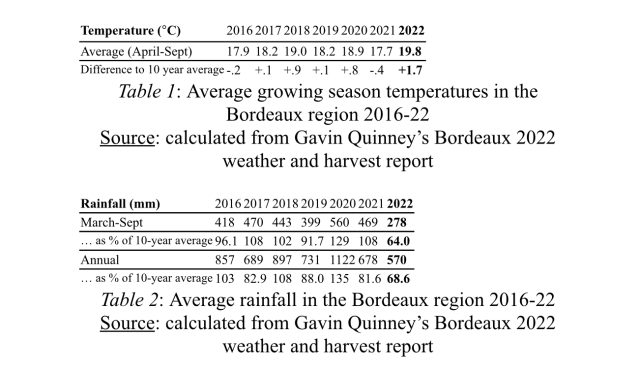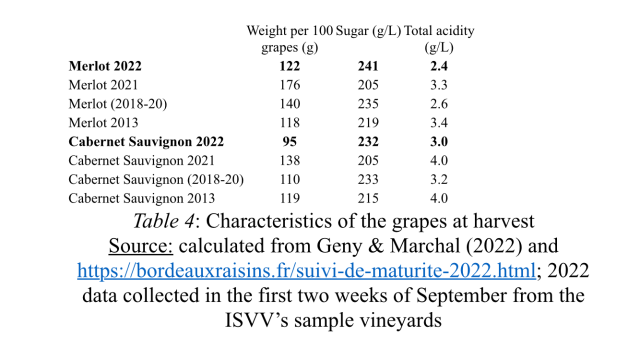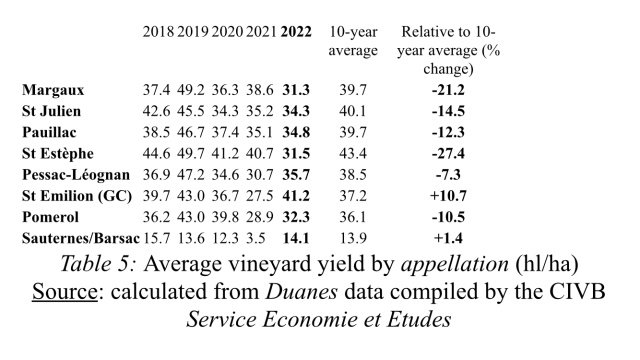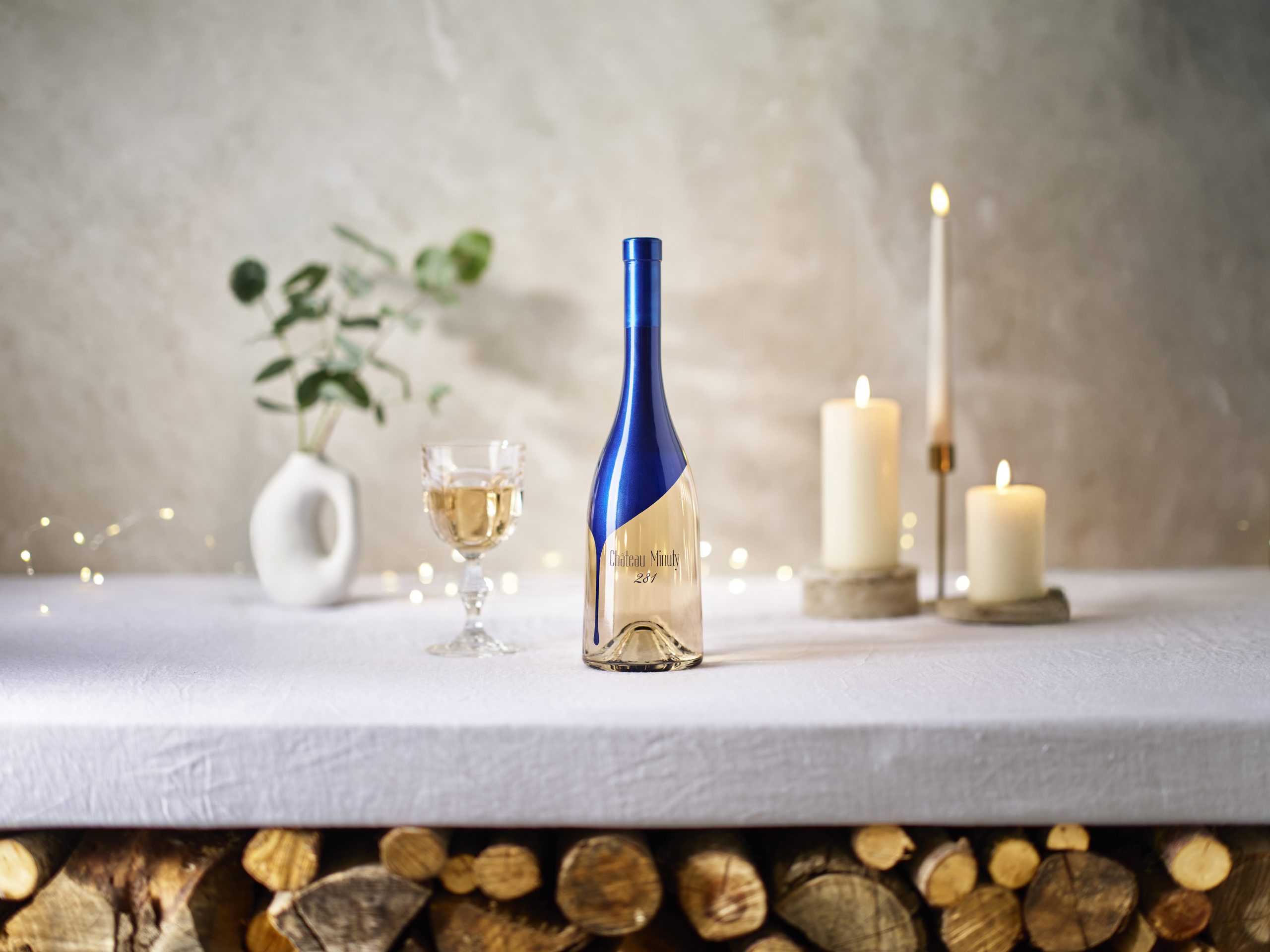Bordeaux 2022 vintage report: Mysterious majesty forged from the enigma of climatic excess
On the eve of the Bordeaux 2022 en primeur tastings, db’s Bordeaux correspondent, Colin Hay, reflects on the meteorological conditions that have contributed to forging the potential greatness of this vintage out of seeming climatic excess.

2022 is a fascinating and extremely promising vintage forged, like its predecessor, out of climatic excess – a mystery wrapped in an enigma.
To understand a vintage – above all, one as complex as this – it is often useful to start with a disarmingly simple question. In twenty years’ time how will 2022 be remembered by those who worked in the vineyard from bud-break to harvest to bring it to us? There is plenty to ensure that their memories of the growing season will remain vivid. Even after two decades there is likely to be much ammunition to fuel the vigneron’s nightmare: intense heat; incessant drought; wildfires in the forests of the Graves, the Médoc and Les Landes; the more generalised risk and associated anxiety of smoke taint; and some of the most violent hail storms the region has seen in living memory with hail stones the size of hens’ eggs.
This is already quite a list of meteorological headaches. And 2022 of course follows a vintage if anything even more marked by meteorological excess. As I noted this time last year, the chronological climatic catalogue of woes that characterised the 2021 vintage included: severe frost, mildew, fruit set following significant rainfall, localised intense hail, brown rot, a late véraison, the continued production of foliage during and after véraison, the absence of any sustained hydric stress, a cool summer and rain during the harvest period (especially for the Merlot), more mildew, grey rot and botrytis. Yet what is striking is that, save other than the (highly localised) hail damage and the (no less localised) frost damage, none of these challenges are the same as those encountered in 2022. Put differently, take the two vintages together and every single conceivable vigneron’s nightmare is present. They are, in fact, almost mirror images of one another: in 2022 wine-makers dreamt of rain; in 2021 they dreamt of heat and drought.
So how, you might well ask, is this a story that could end well? How could potential greatness be forged in conditions such as this? My task in what follows is to offer at least a partial explanation, without at this stage taking too strong a position on the relative quality of the vintage. That would be premature as I have yet to start my tasting in earnest.

But let us assume for now that 2022 will be judged (as it has already been judged by some) an exceptional vintage, at least on a par with the trilogy 2018-2019-2020 and quite possibly greater than all three. What little tasting I have done thus far is certainly consistent with such an evaluation. And that it is credible to think of this as a truly great vintage is already fascinating. It strongly suggests that there is something here to be explained. For recall that most Bordeaux watchers (though, it turns out, by no means all vignerons), were deeply anxious about the quality of the vintage at every stage in the growing season. What happened?
As is ever the case, the best place to look for the answers that might help us resolve the seeming paradox is in the detailed analysis of the growing season itself. In what follows I will concentrate on the climatic conditions that define this vintage – the latest in a succession of unique vintages forged in unprecedented conditions (the French term dérèglement climatique, for me, captures this better than the English ‘climate weirding’).
In so doing I have had the good fortune to be able to draw on the first-hand witness testimony of those who responded to its particular challenges and from the excellent vintage reports produced, respectively, by Axel Marchal and his co-authors from the University of Bordeaux’s Institut des Sciences de la Vignes and des Vins (ISVV), by Gavin Quinney and by Saturnalia. In addition, I would like to thank Axel Marchal from the ISVV and Cécile Ha from the Conseil Interprofessionnel de Vins de Bordeaux (CIVB) for their help in compiling, checking and making sense of some of the data.

In all of these accounts of the vintage, the bottom line is clear. There are, in Axel Marchal’s terms, essentially five pre-conditions for a great vintage. They are:
1, Quick and even flowering and fruit set;
2, Late spring/early summer weather sufficiently dry and warm to facilitate pollination and provide the pre-conditions for even ripening;
3, A gradual rise in hydric stress over the summer (with, above all, a warm and dry July), slowing and ultimately stopping vine growth before véraison (colour change);
4, Ripe grapes with optimum photosynthesis continuing up until harvest (without any significant resumption in vegetative growth);
5, Dry and medium-warm weather during the harvest itself (ideally, with good temperature variation between night and day), allowing picking at optimal ripeness (and freshness).
None of these conditions were present in 2021; they were all present in 2022.
The details of the growing season
The details of the growing season are complex. And that complexity is important if we are to understand the characteristics of the vintage – not least because there is quite a lot of inter-appellation variation. That means that the kind of generalised overview typically presented in the various reviews of the vintage can be misleading (more so than in other recent vintages).
Yet in what follows I draw significantly on these accounts, using a combination of CIVB and IVSS data to descend a little further into the appellation level details only when it is necessary to do so (I will return to more of that detail in my appellation-by-appellation profiles that I hope to publish early in May).
There is, however, no danger in overgeneralisation if we stick to the basics. Overall, the growing season was both unique and extreme – unique in its extremity in fact. It was, in a nutshell, hot and dry. Tables 1 and 2 (below) show that very clearly. Very hot (Table 1). Very dry (Table 2). The latter in particular raises some potentially troubling longer-term issues and implications which transcend the vintage and to which I will return briefly in conclusion.

Yet even here, we need to be careful. Before we move on it is perhaps important to point to some of the limits of this kind of presentation of the data. For as we will see presently, what matters is not necessarily total rainfall but the rainfall that either the plant can use or that replenishes the water table. Rainfall of less than 4 mm in a day especially in the hot summer months is, invariably, of no value to the plant (it evaporates before it is absorbed); and intense rain falling on baked soils often produces as much run-off as it does water than the plant can use. In short, rainfall gauges tend to exaggerate – more and more – effective rainfall.
It is important, then, to begin to get beyond such simple generalisations. To do that requires us to establish the meteorological chronology of events as the 2022 growing season unfolded. For this is by far the best way to tell the story of the vintage.
- That story begins in the winter. There was very little rain in January and February. That made the significant rainfall of December 2021 all the more crucial. 228 mm of rain fell – almost a third of 2021’s total rainfall – in a single month after just 22 mm in the month of November. Arguably, this saved the 2022 vintage. For whilst, overall, there was no significant accumulation of water reserves during the winter months, there was just enough to allow the plants to endure what in effect was turning into a calendar year without (enough) rain.
Yet here already, as Table 3 shows clearly, there are exceptions. The table breaks down rainfall volumes by appellation for the two crucial periods prior to bud-burst (in which the water table was either depleted or replenished) and from colour-change (véraison) to harvest. It shows the total rainfall in each period and (in brackets) the comparison with the 10-year average for the same period. What it reveals is that the water table in the right-bank (Pomerol and, above all, St Emilion) was replenished during the winter, whilst on the left-bank (in the Médoc and the Graves) it was further depleted. In short, the right-bank appellations (most notably St Emilion) were better placed to endure what was to come because there was more water ‘in reserve’.

Partner Content
Odd though it might seem, that the drought conditions of the growing season began early turned out to be a strange and somewhat paradoxical kind of blessing. For, with little winter or spring rainfall (April and May saw around 200 mm of total rainfall as opposed to the more normal 400 mm), the vines began their growing season in search of water. And in the absence from rain from above, they looked inevitably to the water table below. In the process, the younger vines most at risk established deeper root systems than they would otherwise have done (had, for instance, the drought conditions been established only later in the summer). This undoubtedly helped them adapt to the drought-induced hydric stress of the summer months.
As is increasingly normal, bud-break came early. Yet, again, we need to be careful here. For, as Marchal et al.’s data make clear, when compared with the 10-year average the effect is actually quite marginal (since the average itself has fallen significantly in recent years). Rather more significant in fact is that bud-break came significantly later than in 2021, reducing vineyard exposure to the risk of frost damage. So although bud-break came (as it now invariably does) before the frosts of early April and although temperatures fell in some parts of the region to as low as -9, the damage was limited and highly localised. Frost reduced yields much less than in 2021.
Flowering (in mid-May) and (in mid-to-late-July) were both even with no problems of millerandage, even if many properties reported that véraison itself was slow and the period between the two unusually long in the context of recent vintages. The grapes themselves were formed physiologically in drought and were, accordingly, small from the outset. Visible signs of hydric stress (such as drooping foliage and scorched leaves) were present in the vineyards as early as July, especially for young vines and those on less water-retaining gravel and sandy soils. Clay and limestone terroirs and older vines (with better established and more profoundly-embedded root systems), as ever, coped better.
“Permanent hydric stress”
That the vines were in effect in a condition of permanent hydric stress for most of the growing season is hardly surprising when it is considered that there was essentially no rainfall between bud-break and harvest save other than two intense downpours in June. These, too, were vintage-saving events. But here again we need to proceed carefully. For where the rain fell on uncovered baked soils (and even where it didn’t) much of it was simply lost as run-off. The official data, in other words, exaggerate the effective rainfall (and its effect). A close study of the rainfall gauges shows that over 50% of the total rainfall from the start of May until the end of August fell in two days with rather less of it absorbed in those vineyards that needed it the most. Yet, as Marchal et al. emphasise, it was nonetheless absolutely vital. As Table 3 also shows, from véraison until the harvest, rainfall levels were at around half of the 10-year average (less than 50% in the appellations of Margaux, Pomerol and Pessac-Léognan).
July itself was the driest recorded since 1959 (with an average of only 3 mm of rainfall recorded in the six sub-regions of Bordeaux). In such a situation, it is hardly surprising that the irrigation of individual plants was authorised, exceptionally, in the revised cahier des charges (rule book) of the appellations of Pomerol, St Emilion and Pessac-Léognan. However, without the permanent infrastructure to water vines, it was difficult to implement and in fact seldom utilised. It made little or no difference to final vineyard yields.
If 2022 was a vintage forged in drought conditions established early on, it was also a vintage forged in heatwave conditions, above all from May onwards. Average temperatures were between 1 and 3 degrees above the seasonal 10-year average from February onwards, despite a relatively cool March (delaying the onset of bud-break relative to 2021 as we have seen). From May onwards temperatures first soared and then remained exceptionally hot. In total, in the 20 weeks from 7 May, as Gavin Quinney calculates, there were 117 days over 24C (and only 23 under 24C). Of the former, 72 saw temperatures peak at over 28C, with the mercury touching 32C on no fewer than 38 separate occasions. The month of June was the fourth hottest recorded since 1947.
Fresh nights
Night-time temperatures were relatively fresh and certainly well below those of the obvious comparison ‘heatwave vintage’, 2003. There were relatively few nights above 20C and that certainly helped lock in the freshness that is the crucial determinant of greatness in a vintage such as this. Yet, as Saturnalia’s detailed meteorological profile of the appellations show, this is much more true of the right-bank than the left-bank, with diurnal temperature ranges especially low (in comparison with the 10-year norm) in Pessac-Léognan and the northern Médoc appellations of Pauillac, St Julien and St Estèphe.
A three-day spike in temperatures in mid-June, which culminated in temperatures of 40C throughout the region on the 18 June, led to severe and intense hail episodes on the 20 June. Damage was severe, but highly localised, and largely restricted to two well-defined corridors. To the north, a fast moving storm ravaged parts of the northern Médoc (including St Estèphe) before passing just beyond the northern limits of the appellation of Bordeaux Côtes de Blaye. To the south, a second travelling storm impacted the Southern Médoc (between Macau and the city of Bordeaux) with equal severity before passing to the south of Bourg.
The combination of intense heat and incessant drought led, perhaps inevitably (and as it had done in 1959 in similar conditions) to a series of extensive forest fires in late June and early August in the Graves, the Médoc and Les Landes. Bordeaux itself was temporarily shrouded in smoke. Vignerons, above all those with vineyards close to the flames or in the path of the acrid smoke shadow that it created, feared that they might lose the entire vintage to smoke taint. In the end, the topography of the region contributed to reducing the risk and, in the final analysis it seems, no taint of smoke will be detectable in the wines of any appellation of the region.
In the vineyard, the incessant heat and drought conditions led to less de-leafing and more canopy maintenance. The retention of vegetal cover between the vines was also a significant factor, reducing day time peak soil temperatures by up to 10 degrees and hence changing entirely the physiology of the plant as well as reducing water loss through transpiration. 2022 has undoubtedly contributed to making such practices much more widely distributed than previously. What is also clear is that the 2022 vintage has proved a test of the health of one’s soil and one’s vineyard management.

Unremarkably, perhaps, the harvest came early, with the start of the Merlot picking at Cheval Blanc for instance before the end of August for the first time ever. The grapes were harvested at optimal ripeness and in perfect health without any pressure arising from concerns about maladies in the vineyard. But the crop itself is small. As Table 4 shows very clearly, this is a simple reflection for the most part of the small size of the grapes themselves. Other than in St Estèphe (where the average vineyard yield was significantly impacted by the storm of 20 July) it has little or nothing to do with frost or hail damage.

The small, thick-skinned and highly concentrated character of the grapes (with high tannic content and little juice) called for cautious and gentle extraction. With IPT levels typically 15 per cent higher than in even 2018 and 2020, maceration needed to be gentle and, invariably, shorter than in recent vintages.
With high potential alcohol levels we are also likely to see more use of whole-bunch fermentation (a technique up until now almost synonymous with Guillaume Poutier’s mini-revolution at Carmes Haut-Brion) and the greater use of indigenous yeasts (which are invariably less efficient at converting sugar to alcohol). But the excellent news here is that the higher alcohol levels would appear to be well-balanced by compensating freshness, with pH levels comparatively low (especially given the surprisingly low levels of acidity recorded by the ISVV in their sample vineyards at the date of harvest).
Lower yields
Overall yields are, then, down as is clearly shown in Table 5. But whilst they are, on average, similar to those attained in 2021, they are rather differently distributed. The cooler and more water-retaining soils of St Emilion fared best – in part because of greater replenishment of the water table in the winter months and also the competitive advantage offered by limestone and clay terroirs in vintages like this. Yields were typically lower in the Médoc for a variety of reasons (from hail in St Estèphe to intense drought and its elevated effects on less water-retaining soils in Margaux, St Julien and Pauillac). Yields are somewhat in between in Pomerol and Pessac-Léognan, but still well below the average of the last decade.
But what will perhaps depress Bordeaux producers more than anything is that this is yet another (prospectively) ‘great’ vintage with lower than average yields (like 2020 before it). They will worry that this is becoming a pattern – and a pattern that bears the imprint of global warming. Some, perhaps, will feel a certain financial pressure to compensate for lower yields (above all in a context of high anticipated demand for the vintage) by including in their first wines parcels that might better be left for the second wine (those, for instance, on less water-retaining soils). This might well turn out to be a source of property-level heterogeneity.

A note on the whites wines of the vintage
The preceding analysis has focused almost entirely on the red wines on the vintage. That is perhaps unsurprising. For, as Axel Marchal and his colleagues observe, “hot, dry vintages are generally not the best for whites varietals”. Yet the dry white wines of this vintage are more promising than that would suggest. For whilst elevated summer temperatures have indeed reduced acidity levels whilst boosting sugar and, hence, potential alcohol levels, the all-important rains of June allowed the vines to preserve good levels of freshness and aromatic complexity. This is above all the case on more water-retaining soils (clay, limestone or clay-limestone). As Marchal et al. conclude, “the white grapes were harvested in perfect sanitary conditions, historically early, and before the high temperatures of late August and early September; they are of a good quality”.
And what of Sauternes and Barsac, so often overlooked in analyses of this kind? Here the bottom line is if anything better still. 2022 is likely to prove a rare and wonderful vintage in both Sauternes and Barsac. It will richly reward the patience of those who were prepared to take the risk of waiting to pick until the optimal concentration of the grapes had been achieved after the late onset of botrytis and the slow return to the warm and dry conditions required to impart its signature on the grapes. After an annus horribilis in 2021 I look forward to toasting their success during the tastings to come.
On the eve of an intense period of en primeur tasting, many questions inevitably remain to be answered. In a follow up piece, Hay outlines the conundrums. Read more here.
Related news
Castel Group leadership coup escalates
For the twelfth day of Christmas...
Zuccardi Valle de Uco: textured, unique and revolutionary wines




